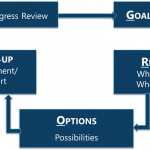Engage, Inform, Persuade
How to Inspire and Connect Every Time
The Challenge
Do you want to leave a mark and to be remembered by the people you meet and have a positive impact where it really counts? Every conversation, every meeting, and even every email is an opportunity to make a positive impact and build meaningful relationships. The good news? This is possible for all of us if we focus on clear communication, follow a simple process, and use the right tools.
Looking Back: Where Did I Miss the Mark?
Have you ever wished you could go back and say what you should have said, write what you should have written, or re-live a moment with more wisdom? I know I have. This is my story of looking back and realizing how much I would change if I knew then what I know now.
I spent most of my career in sales and marketing roles that gave me the privilege of connecting with others, whether one-on-one or through presentations. For part of that time, I trained others in communication skills. But today, with over 50 years of experience behind me, I want to tell you, honestly, the mistakes I made and key lessons I learned. Here’s the biggest lesson I’ve learned: “Life is all about relationships, and communication is the lifeblood of those relationships.”
Sadly, many of us don’t give communication the attention it deserves. It’s not about how well I think I’ve communicated — it’s about how the other person feels after speaking with me, reading my email or listening to my presentation. As the saying goes, “People may not remember what you said, but they will remember how you made them feel.”
If I could go back and redo my 50-year career, that would be my focus. Whether in conversation, email, or presentations, it all comes down to how well I connect and how people feel.
Everyone Loves a Good PIE
Dr. Gordon Ko shared a simple tool or process that changed my thinking about communication: PIE. Want to be remembered? Give people a good PIE.
PIE, spelled backwards, gives us EIP — three simple steps:
- E = Engage
- I = Inform
- P = Persuade
Let’s break that down:
Every Pie Needs a Purpose
When you ask a baker for a pie, the first question is: What kind of pie? Each one has a purpose. A fruit pie for dessert, a meat pie for dinner, or a spinach pie for healthy eating. The best bakers are passionate about their specialty.
The same applies to presentations. Start with a clear purpose, a purpose or subject that you are passionate about and that aligns with your audience’s needs. What do they care about? Why should your audience care about the same purpose, issue or need? What do they hope to learn or feel as a result of your talk, conversation or even your email? Once this is clear in your mind, start creating your amazing PIE.
Engage — Start Strong
Engagement is everything. Without it, you risk being forgotten — or worse, having a negative impact.
You engage through your first impression, your body language, the stories you share, and the passion you communicate. Stories are powerful. We remember Jesus’ parables more than the details of His sermons because stories engage both the logical and emotional sides of the brain.
And here’s an important caution: PowerPoint can ruin a presentation. Let me explain.
As president of Microsoft, Bill Gates created PowerPoint. Bill is one of the most impactful presenters on TED Talks. if you watch his presentation on the environment, you will notice that he did not use PowerPoint. Because the misuse of PowerPoint can destroy your audience engagement.
Here is another example: I once attended an hour-long Zoom presentation by a leading doctor on overcoming chronic pain. His PowerPoint slides filled my screen. His face and body language were relegated to a small corner on top of the screen. It was impossible to see his eyes or the expression on his face. My eyes were focused on slides filled with text and charts. I could not listen to his words or his heartfelt delivery. The truth is, I would have been better off if he had sent me his slide deck or the paper he had already published on the subject.
Here are some PowerPoint tips:
- Use slides sparingly and only when necessary. Fewer slides help your audience focus on your spoken message rather than reading too much on-screen. Quality over quantity keeps attention.
- Use images or simple diagrams to support your message and enhance engagement. A picture of a bridge can symbolize connection, supporting your words and making abstract ideas memorable and easy to understand.
- Keep text minimal — no more than eight words per slide. Short text like “Clear vision needs clear focus” reinforces key points without distracting from your speaking and keeps attention on you.
- Great images can be found for free at Pexels or Unsplash. Using professional-quality images from these sites avoids blurry or unprofessional visuals, improving credibility and making slides visually appealing.
- If presenting online:
- Over-impose your face on top of the slides. Seeing your face builds trust and connection; it reminds the audience there’s a real person behind the content, increasing engagement. PowerPoint 365 has a function called “Camio” which helps you do just that.
- Give your face at least 25% of the screen area. A visible face adds warmth and human connection, helping viewers stay focused on both your message and you as the speaker.
Inform — Tell Me Something New
Here’s the hard part: Most people already know a lot about the topics they care about. Plus, with the internet, answers to most questions are just a click away.
So, how do you make a lasting impression? Mark Goulston, in his book Just Listen, says: “People don’t change because of what you tell them — they change because of what you get them to say.” This highlights the fact that questions are more powerful than answers. For example, instead of lecturing me about healthy eating, ask: “In five years, what health risks might you face if you don’t change your eating habits? How might that affect your family?” See the difference?
Persuade — Inspire Action
Finally, challenge me to act. Suggest simple, practical next steps. Don’t just talk about big goals — show me the small, achievable steps I can take today. Point me toward the resources and support I need. We live in a world of constant change. Help others spot the “low-hanging fruit” and guide them toward progress.
Unlock the Power of Speaking: Learn to Talk Like TED
If I could change one thing in my career, it would be learning much earlier how to Talk Like TED. Why? Because great communication opens doors, inspires action, and transforms ideas into movements.
Carmine Gallo’s Talk Like TED isn’t just a book — it’s a toolkit packed with proven strategies from the world’s most powerful TED speakers. Whether you’re addressing a boardroom, pitching an idea, leading a meeting, or sharing a vision with your community, these techniques will help you connect, engage, and leave a lasting impression. In a way, this book affirms the importance of the PIE process and principles.
Here’s what you should put into practice:
- Be Emotional: Facts inform, but emotions move people. The best presentations make you feel something. They use personal stories, vivid examples, and contagious passion. Think about what excites you and let that energy show. Your enthusiasm will be impossible to ignore.
- Be Novel: Our brains crave new information. Introduce something surprising, fresh, or counterintuitive that sparks curiosity. Ask yourself: What unique angle or insight can I share that others haven’t heard? Your audience will sit up and pay attention.
- Be Memorable: Concrete images, simple language, and unforgettable examples stick in people’s minds. Don’t clutter your message with jargon or complexity. Instead, paint pictures with words. Make your key points easy to remember and repeat.
- Package Ideas Beautifully: The delivery matters. Use visuals, confident body language, and purposeful pauses. You’re not just conveying data — you’re telling a story that matters.
- Practice Makes Perfect. Whether you are Bill Gates or General Colin Powell, TED presenters are limited to a maximum of 18 minutes. To do this well, it is reported that TED presenters rehearse their presentations 50-200 times. That makes them perfect in the limited time they are given.
If you’re serious about communicating with impact, do yourself a favour: dive deeper into these ideas. Even if you’re pressed for time, here are quick resources to help you start applying them right away:
- Video Summary: Watch Talk Like TED highlights on YouTube. https://youtu.be/nCw659aZak0?si=jAqiYfL2Twu79hE7
- Written Summaries:
- Read Cracking the TED Code https://www.wearetierone.com/blog/cracking-the-ted-code-takeaways-from-talk-like-ted-the-9-public-speaking-secrets-of-the-worlds-top-minds.
- Explore the Four Minute Books summary https://www.wearetierone.com/blog/cracking-the-ted-code-takeaways-from-talk-like-ted-the-9-public-speaking-secrets-of-the-worlds-top-minds
In today’s world, being able to share ideas with clarity and conviction is a superpower. Don’t leave it to chance. Start learning to Talk Like TED — and watch doors open, connections deepen, and opportunities grow.
In Closing
Everyone loves a good PIE. Every encounter is a chance to make someone feel valued, inspired, and motivated. Whether in conversation, writing, or presentations, focus on purpose, engagement, fresh insights, and actionable encouragement.
Because in the end, it’s not about what you said or what you think — it’s about how you made them feel.


